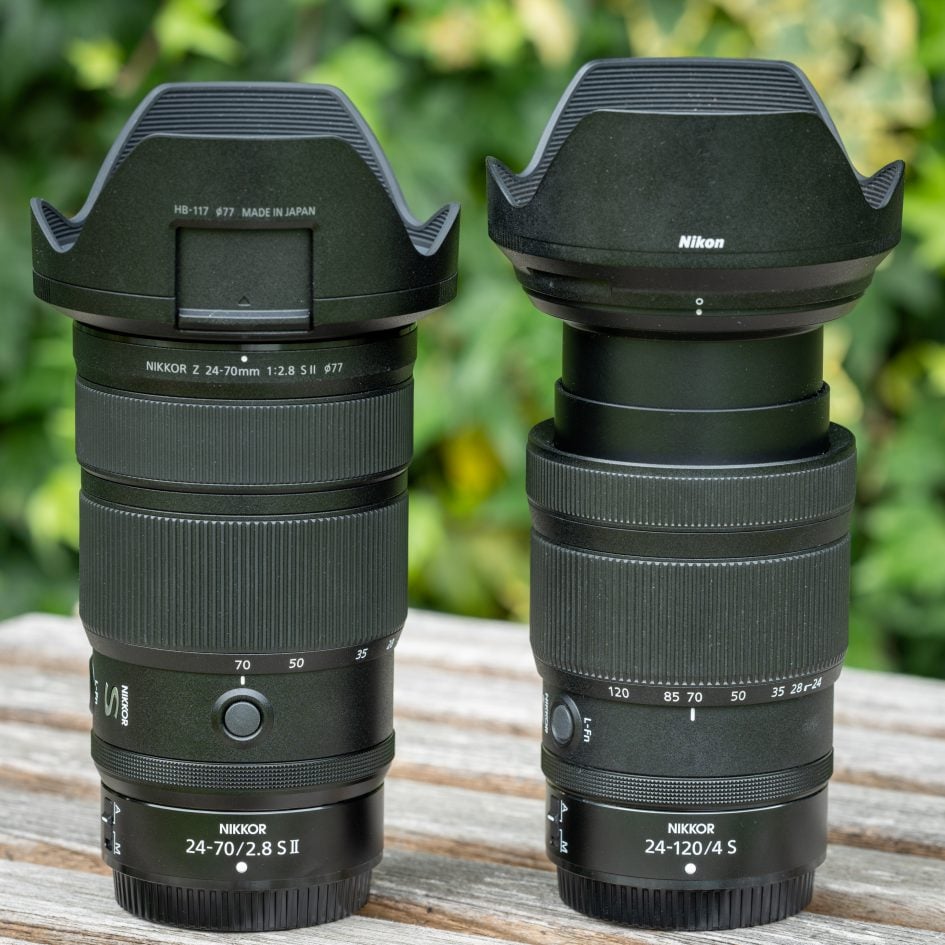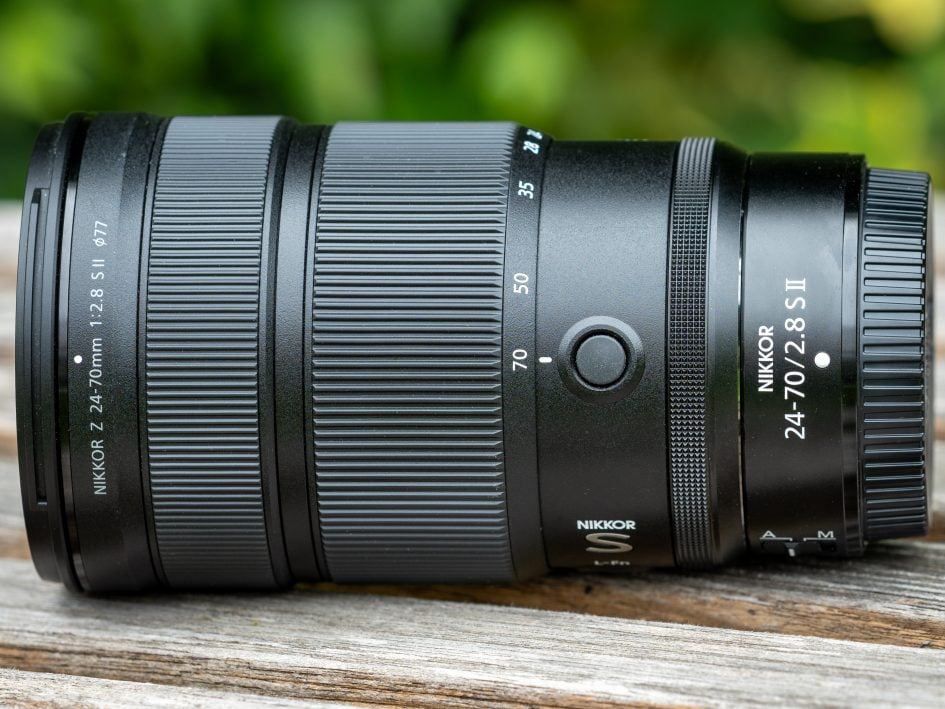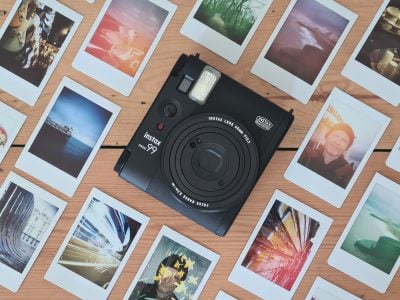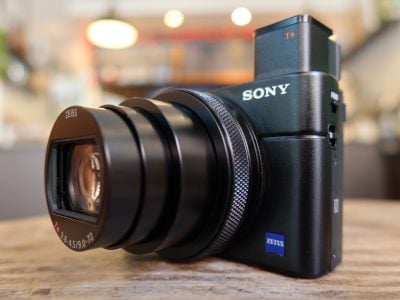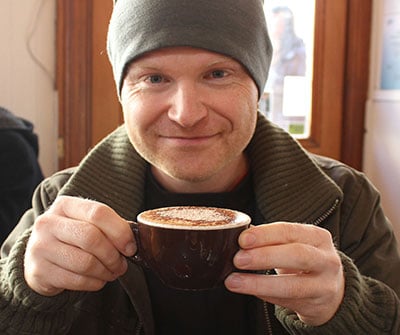Nikon Z 24-70mm f2.8 S II review
-
-
Written by Thomas
Intro
The Nikon Z 24-70mm f2.8 S II is a professional general-purpose zoom designed for Nikon’s full-frame Z-series mirrorless cameras – and the first lens in Nikon’s line-up of Z-Nikkors to get an update. Its predecessor, the Z 24-70mm f2.8 S, was announced in February 2019 as the first Z-Nikkor zoom with a fast f2.8 focal ratio.
Nikon changed the optical formula of the Z 24-70mm f2.8 S II to an internal zoom design claiming better weather proofing, less focus-breathing, and no shift in the center of gravity while zooming. They also improved maximum magnification by 50%, made the new lens lighter, added a second customizable function button and a focus limiter, upgraded the focus drive from a stepper motor to a faster voice coil drive, applied their latest meso-amorphous coating, and incorporated two features previously absent in Z-Nikkors: a lens hood with a window for easier use of rotating filters and a multi-function control ring that can now be set to provide clickable tactile feedback, such as when adjusting the aperture. The only features of its predecessor which didn’t make it to the new lens: The OLED display for indicating focal length, aperture, focusing distance and depth-of-field, and the fluorine-coating of the rear lens element (the front element is still coated).
The Nikon Z 24-70mm f2.8 S II is made in Japan and costs 2899 EUR (incl. 19% VAT) / 2797 USD / 2599 GBP. Read on for a detailed comparison of facts and features of the new lens and its predecessor and a very close look at its optical qualities – using pixel shift shooting on a Nikon Z8 which quadruples the resolution of the camera to 180MP.

Facts and features
Let’s compare the Nikon Z 24-70mm f2.8 S II to its predecessor, the Nikon Z 24-70mm f2.8 S, and the Tamron 28-75mm f2.8 Di III G2 (“Tamron” for short). As usual I’ve rated the features with a [+] (or [++]), when it’s better than average or even state of the art, a [0] if it’s standard or just average, and [-] if there’s a disadvantage.
Size (diameter x length): 84 x 142mm (3.4 x 5.6in.) plus 43mm for the lens hood (107mm in diameter). The new lens doesn’t change length during focusing or zooming. The predecessor is quite a bit shorter at 24mm focal length: 89 x 126mm + 41mm lens hood. But it extends by 30mm when zoomed in to 70mm focal length. The Tamron is 76 x 120mm + 28mm lens hood + 18mm extension. [0]
Weight: 675g (23.8 oz.) plus 48g for the lens hood compares favorably to the 803g + 43g lens hood of its predecessor. But the Tamron is even lighter at 550g + 27g lens hood. [0]
Optics: Nikon simplified the optical design considerably with 14 elements (including 2 special dispersion elements and 3 aspherical elements) in 10 groups down from 17 elements in 15 groups. This reduces the number of glass/air surfaces by 10, making it easier to avoid/reduce reflections. The Tamron also has 17 elements in 15 groups. Both Z-Nikkors use Nikon’s “ARNEO” anti-reflective coating to reduce flare, glare and ghosting but only the new Z 24-70mm f2.8 S II profits from additional Meso-amorphous coating. [+]
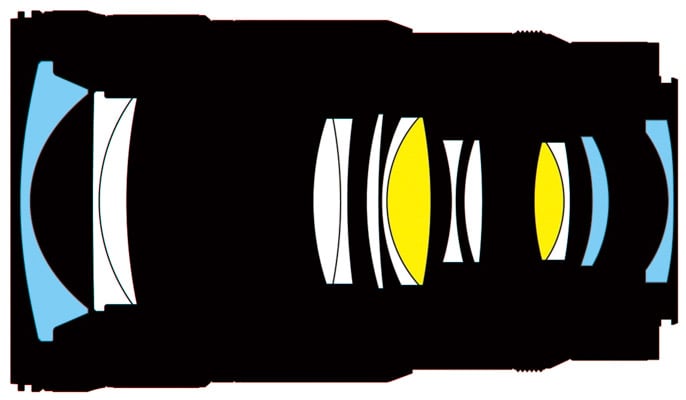
Nikon Z 24-70mm f2.8 S II (above), Nikon Z 24-70mm f2.8 S (below)

Minimum object distance is 0.24m (9.4in.) with a magnification of 1:4.5 and a very short working distance of 8cm (1.6in.) at 24mm focal length. At 70mm focal length maximum magnification is 1:2.8 which is quite good and results in a better working distance of around 17cm (1.1ft.). At 70mm focal length a magnification of 1:10 is achieved at 0.63m distance. The predecessor achieves a maximum magnification of 1:4.2 at 70mm focal length and a working distance of 20cm. The Tamron has an MOD of 0.18m with a magnification of 1:2.5 and an extremely short working distance of 4cm at 28mm focal length. At 75mm focal length maximum magnification is 1:3.7 with a working distance of around 22cm.[+]
Filter-thread: 77mm just like the Nikon Z 70-200mm f2.8 S. The predecessor needs larger and more expensive 82mm filters. The Tamron takes 67mm filters. [+]
Image stabilization: None of the lenses in this comparison offer optical stabilization (VR). But Nikon’s full-frame Z bodies provide built-in sensor-shift stabilization over 5 axis – plus an optional electronic stabilization in video mode. [0]
Auto focus: All lenses in this comparison offer autofocus with built-in focus drive. But Nikon swapped the stepper motor to a voice coil drive (SSVCM). Tamron also has a voice coil drive. Manual-focus override is by simply turning the dedicated focus ring. The focus ring has the usual variable gearing which allows for very precise manual focus when turned slowly. You can reverse the focus ring direction and switch to linear response with different settings for focus throw in camera. [+]
All lenses in this comparison cover full frame sensors or can equally be used on a cropped DX sensor. The angle of view of a 24-70mm zoom lens is equivalent to a 36-105mm zoom lens on a cropped sensor. [+]

Display: No, the Nikon Z 24-70mm f2.8 S II does not features the OLED display of its predecessor or some other S-class lenses. Same with the Tamron. [0]
Price: 2899 EUR (incl. 19% VAT) / 2797 USD / 2599 GBP. The older version currently goes for 2150 EUR / 2100 USD / 2100 GBP. The Tamron is much cheaper at 850 EUR / 850 USD / 650 GBP. [-]
Both Z-Nikkors come with a flimsy pouch which has no strings to pull it close. So if you put the lens in your bag it might easily slip out of its pouch and bang around unprotected. This is simply unacceptable for a lens costing north of 2500 EUR/USD/GBP. The lens hood is included and locks in place to avoid accidentally falling off plus it is reversible for transport. The new version has a windowed design which allows for easier access to rotating filters like polarizers but puts away with the black velvet coating of its predecessor. The Tamron comes without a pouch and the reversible lens hood is included but has no lock and no filter window. [+]

Aperture ring and other control elements: Like many Z-Nikkors both 24-70mm f2.8 zoom lenses have a slim multi-function control ring at the back of the lens in addition to the dedicated focus ring. The control ring can be assigned to operate the aperture (which is the default), exposure compensation, or ISO sensitivity – or simply switched off. The new Z-Nikkor has a switch on the right side to make the ring clickable for more tactile feedback e.g. when operating the aperture, or smooth which is preferred for adjustments in video. The Z 24-70mm f2.8 S II also has an AF/MF switch and two extra L-Fn buttons which can be assigned many different functions e.g. AF-lock. This is different from its predecessor which only has one L-Fn button and makes it easier to operate the button when shooting in portrait orientation. There is also a switch to limit close focus to 33cm, which is the closest focus the lens can achieve at every focal length. The Tamron has one focus set button which can be assigned more functions via Tamron’s Lens Utility (TLU) than what the Z-Nikkors have to offer. [+]
Lens profile: All three lenses come with an integrated lens profile which can be controlled from the camera. Vignette control offers the usual options of High, Normal, Low and Off. Diffraction compensation and Auto distortion control can be activated or deactivated. Adobe supplies a profile for RAW development of the Tamron lens. [+]

Sealing: All lenses in this comparison have a rubber grommet at the lens-mount plus further special weather-sealing throughout the construction. But only the new Z-Nikkor has an internal zoom, which is easier to protect from the elements than the extending barrel designs of the other zooms. Both Nikon and Tamron employ fluorine coating on the front lens to repel water, dust, and dirt and should make for easier cleaning. The Z 24-70mm f2.8 S also had the rear lens coated. [+]
At a score of 1[-]/4[0]/9[+] the Nikon Z 24-70mm f2.8 S II is an exceptionally well featured design – albeit at a high asking price. It is lighter than its predecessor, has a promising new optical formula and finally sports two features that other Z-Nikkors sorely miss: A (de-)clickable function ring and a lens hood with a filter window. You may miss the OLED display of its predecessor but I think not many users valued this highly.
Two zoom lenses starting at 24mm
Above: Nikon Z 24-70mm f2.8 S II (left), Nikon Z 24-120mm f4 S (right)
Coverage
With its 2.9x zoom-range both 24-70mm Nikkors start at the short end with an angle of view of 84 degrees (diagonally), compared to the 75 degrees of zoom lenses starting at 28mm. Here is the angle of view that the Nikon Z 24-70mm f2.8 S II covers compared to the Tamron 28-75mm f2.8 Di III G2 (Distortion control set to On):
Above: Nikon Z 24-70mm f2.8 S II coverage on a full-frame camera at 24mm (left) and 70mm (right); click image for 4k version
Above: Tamron 28-75mm f2.8 Di III G2 coverage on a full-frame camera at 28mm (left) and 75mm (right); click image for 4k version
The difference between a zoom lens starting at 24mm versus a lens starting at 28mm is visible but doesn’t look like much. But still: Not always can you step back enough to get the 9 degrees wider view of 24mm focal length.
At the long end the Tamron achieves a 7% larger magnification than the Nikkor. To achieve the same angle of view you’d need to crop a 45MP image shot at 70mm down to 39MP – a loss in resolution which is barely noticeable.
Focus and zoom
Focus accuracy and repeatability is critical to consistently produce sharp shots. Repeatability (the accuracy of focus on the same subject after repeated focus-acquisition) of the Nikon Z 24-70mm f2.8 S II is very good at the short end (98.5%). But at 70mm Reikan FoCal measured only 96.6% consistency. There were no clear outliers over a series of 40 shots on the well lit and contrasty focus test target but quality of focus often was 10% below optimum when coming from a closer distance.
On a Z8 and at 70mm focal length the Z 24-70mm f2.8 S II focuses extremely fast at around 0.13 sec from infinity to 0.63m (1:10 magnification). The predecessor took 0.35 sec measured with Reikan Focal and I clocked the Tamron 28-75mm f2.8 Di III G2 at around 0.3 sec. This is not the 5x improvement in focus speed from the voice coil drive which Nikon claims but it’s none-the-less much faster than the stepper motor in its predecessor. Btw: The strong magnetic field from the new drive made Nikon advise you to keep at least 5cm distance from cardiac pacemakers. Another consequence of the new drive technology: When powered down the focus group(s) inside the lens can move freely which leads to a low clunking sound when you shake the lens. But that’s the same with every other voice coil driven lens I tested so far.
The zoom ring has a throw of about 92 degrees and a 31mm wide rubber surface with a good grip. Rotation is pretty stiff, still the lens shows a little bit of zoom creep. The focus ring is 19mm wide and is located at the front. It also has a rubberized surface, moves smoothly, and can easily be operated even with your pinky.
In photo mode AF-operation is almost inaudible from the outside or when you record video with the built-in microphone. Manually turning the focus ring registers as a very slight friction noise – while turning the zoom ring is a bit louder and ends in an audible “tock” when you hit either end of the zoom range.
Regarding focus breathing: The Z 24-70mm f2.8 S II did not show any change in magnification at all when I pulled focus. Perfect! Images from the Nikon Z 24-70mm f2.8 S became 3.5% smaller respectively 1.5% larger from the Tamron 28-75mm f2.8 Di III G2 when I adjusted focus from infinity to 0.77m resp. 0.85m.
I also tested whether Nikon’s new zoom lens allows you to change the focal length without altering its focus. This characteristic is called parfocal. I focused the lens at 70mm and then slowly zoomed back checking focus on the way. The Z 24-70mm f2.8 S II kept its focus perfectly over the complete zoom-range while its predecessor became gradually less sharp when zooming back. The Tamron 28-75mm f2.8 Di III G2 is also perfectly parfocal.
And there is another point where Nikon improved the Z 24-70mm f2.8 S II: Its nodal point (optical center) remains fixed during zooming, unlike the previous model, which shifted over 2cm. The nodal point is crucial for panoramic photography because rotating the camera around it eliminates parallax error, ensuring that foreground and background objects align correctly when stitching multiple images together. So, the older lens required camera repositioning on a panoramic head with focal length changes, which is a nuisance.
Btw: The Nikon Z 14-24mm f2.8 S also has a nodal point which does not shift with zooming. It’s located at around 10cm in front of the lens mount, almost identical to the Z 24-70mm f2.8 S II. I couldn’t test if there’s a meaningful difference between both nodal points, and I don’t know whether this was an intentional design decision by Nikon: But if both lenses have matching nodal points that would make them a dream pair of zoom lenses for panoramic photography!
Next check out my quality results!
Check prices on the Nikon Z 24-70mm f2.8 S II at B&H, Adorama, WEX UK or Calumet.de. Buy used gear from MPB. Sell your used gear to MPB. Alternatively get yourself a copy of my In Camera book, an official Cameralabs T-shirt or mug, or treat me to a coffee! Thanks!
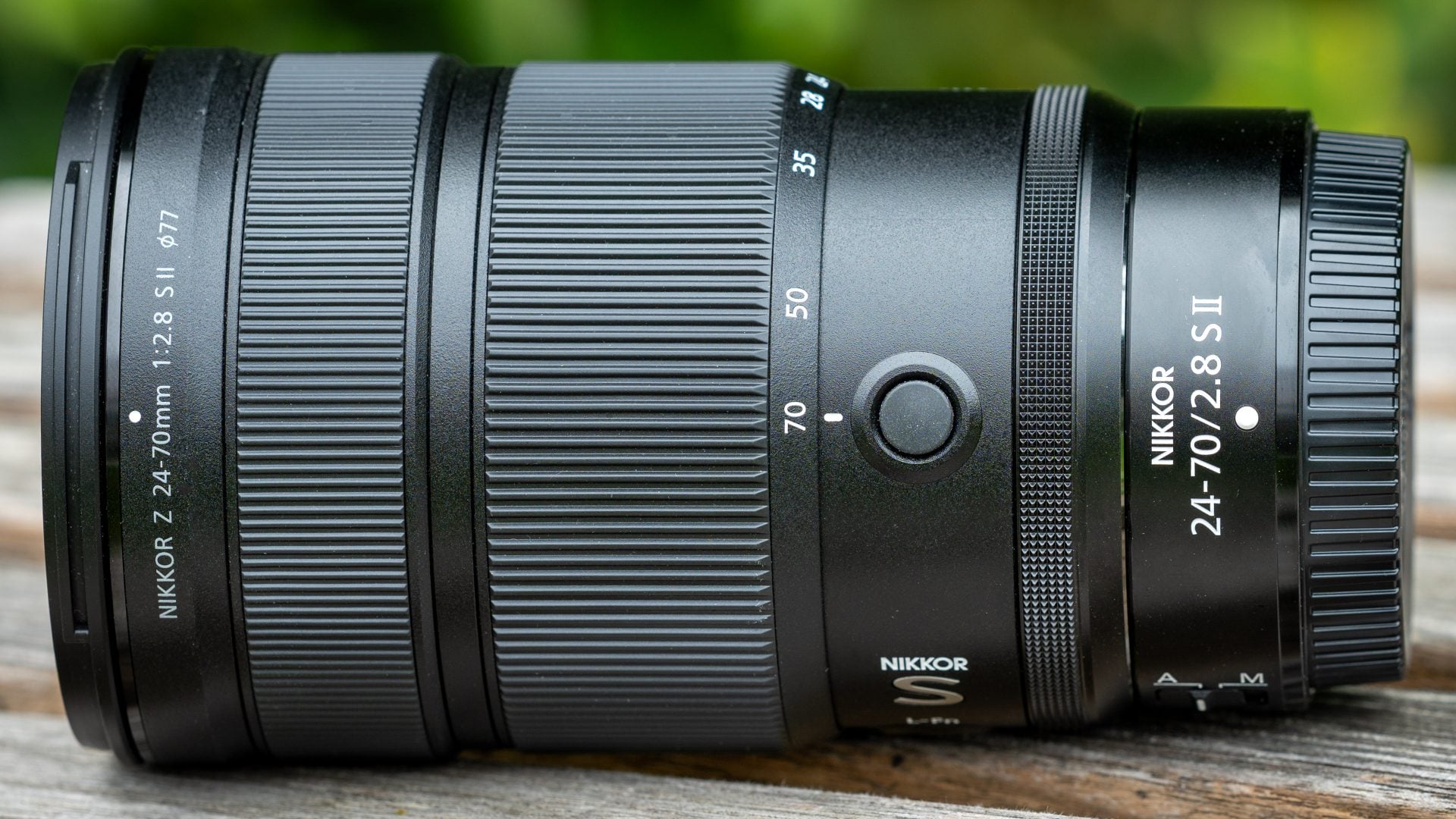
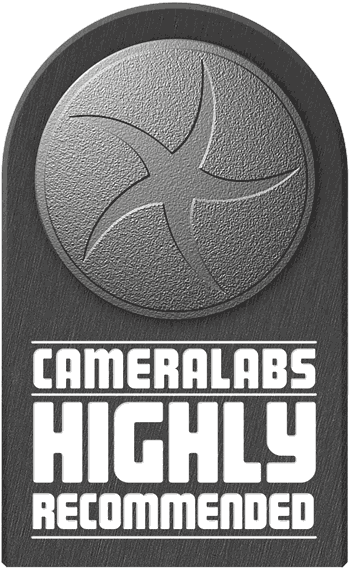 Nikon equipped their new Z 24-70mm f2.8 S II with an impressive set of features, two of which are even unique to any Z-Nikkor: a (de-)clickable function ring and a lens hood with a window for easier manipulation of rotating filters. Equally impressive is the new voice coil AF-drive which is 3x faster than before. The new lens also removes focus breathing, increases maximum magnification by 50%, improves FX-corner sharpness, and enhances weather sealing. It is perfectly parfocal and keeps its optical center during zooming, which benefits panoramic shots. The Z 24-70mm f2.8 S II delivers sharp images across the frame with a slight softening at 70mm, has a smooth bokeh, minimal color aberrations, and strong flare resistance. But although the lens comes at a high price, is slightly less sharp at the DX-corners compared to its predecessor (at least my copy), and shows some mixed AF consistency at the long end, I can still highly recommend it.
Nikon equipped their new Z 24-70mm f2.8 S II with an impressive set of features, two of which are even unique to any Z-Nikkor: a (de-)clickable function ring and a lens hood with a window for easier manipulation of rotating filters. Equally impressive is the new voice coil AF-drive which is 3x faster than before. The new lens also removes focus breathing, increases maximum magnification by 50%, improves FX-corner sharpness, and enhances weather sealing. It is perfectly parfocal and keeps its optical center during zooming, which benefits panoramic shots. The Z 24-70mm f2.8 S II delivers sharp images across the frame with a slight softening at 70mm, has a smooth bokeh, minimal color aberrations, and strong flare resistance. But although the lens comes at a high price, is slightly less sharp at the DX-corners compared to its predecessor (at least my copy), and shows some mixed AF consistency at the long end, I can still highly recommend it.